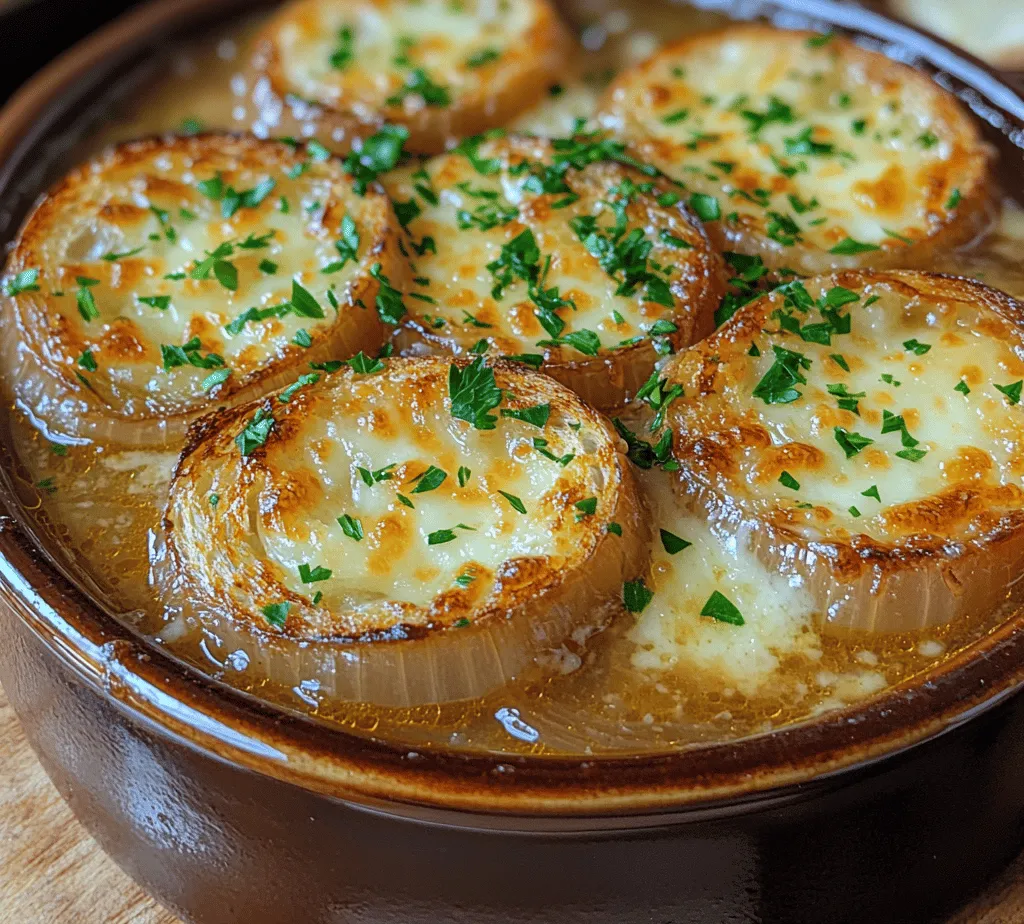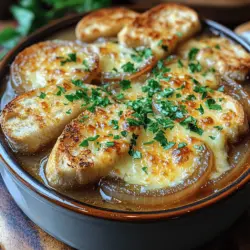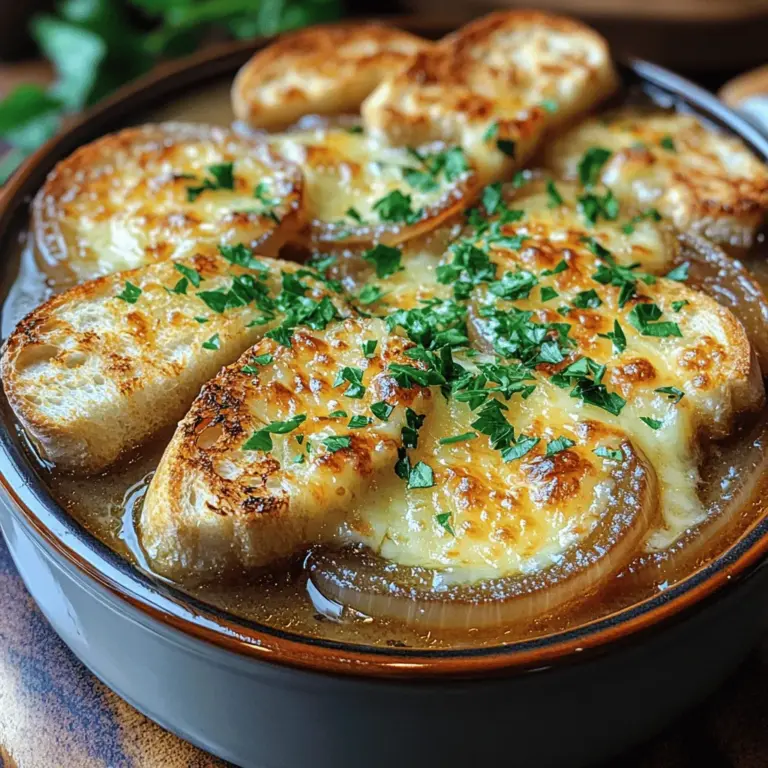Introduction to Classic French Onion Soup
French Onion Soup is a culinary classic that has captured the hearts and palates of food lovers around the world. Renowned for its rich, savory flavor and comforting warmth, this dish is a staple in French cuisine and boasts a history that dates back centuries. Whether enjoyed as a starter in a fine dining restaurant or savored at home on a chilly evening, French Onion Soup is more than just a meal; it’s an experience that evokes nostalgia and satisfaction.
The essence of French Onion Soup lies in its simplicity and the quality of its ingredients. At its core, this dish features caramelized onions swimming in a flavorful broth, topped with a crusty layer of melted cheese. The magic of this soup is in the caramelization process, where the natural sugars in the onions transform into a deep, golden-brown sweetness that forms the foundation of the soup’s flavor profile. When prepared with care and patience, French Onion Soup becomes a harmonious blend of sweet, savory, and umami notes, making it a beloved comfort food for many.
The History and Origin of French Onion Soup
The origins of French Onion Soup can be traced back to ancient Rome, where a similar dish made with leeks and onions was consumed. However, the modern version that we know today began to take shape in the 18th century in France. It is said that this rustic dish was a favorite among the working class, often made from simple ingredients that were readily available. The soup was typically cooked slowly over low heat, allowing the onions to caramelize and develop their rich flavor.
As the recipe evolved, it became a hallmark of French bistro cuisine, appearing on menus and gaining popularity among diners. Its comforting nature and the satisfaction derived from the warm, cheesy topping made it a favorite among patrons, further solidifying its place in French culinary tradition. Over time, French Onion Soup transcended its humble beginnings, transforming into a symbol of culinary sophistication and comfort.
In contemporary cuisine, French Onion Soup remains a popular choice in both restaurants and home kitchens. Its versatility allows for variations, with some cooks opting for different types of cheese or broth, but the essence of the dish remains the same. Today, it is celebrated not only for its flavor but also for the sense of warmth and comfort it provides, making it a go-to recipe during colder months.
Ingredients for Classic French Onion Soup
To create the perfect bowl of French Onion Soup, it’s crucial to select high-quality ingredients that will contribute to the depth of flavor and overall success of the dish. Below is a breakdown of the essential ingredients and their roles in this classic recipe:
Yellow Onions: The Star of the Dish
The foundation of French Onion Soup is, without a doubt, the yellow onion. These onions are known for their natural sweetness, which is essential for achieving the perfect balance of flavors. When caramelized, yellow onions develop a rich, deep flavor that is the hallmark of this soup. It is recommended to choose onions that are firm and free from blemishes to ensure the best quality.
Unsalted Butter and Olive Oil: Base for Flavor
A combination of unsalted butter and olive oil serves as the cooking fat for this recipe. The butter adds a rich, creamy texture, while the olive oil helps to prevent the butter from burning during the caramelization process. This combination not only enhances the flavor of the onions but also contributes to the overall richness of the soup.
Broths: Importance of Beef and Chicken Broth Combination
The broth forms the base of the soup and is crucial in delivering flavor. A blend of high-quality beef broth and chicken broth is often used to create a robust and well-rounded flavor profile. The beef broth adds depth and richness, while the chicken broth provides a lighter note, creating a perfect balance. For those seeking a vegetarian option, vegetable broth can be used, but it’s essential to choose a flavorful variety to maintain the integrity of the dish.
Wines: Role of Dry White Wine
Incorporating a splash of dry white wine into the soup elevates its flavor and adds complexity. The acidity of the wine helps to cut through the richness of the broth and cheese, enhancing the overall taste. When selecting a wine, opt for one that you enjoy drinking, as the flavor will be concentrated in the soup.
Cheeses: Gruyère and Parmesan for the Ultimate Topping
No French Onion Soup is complete without a generous topping of cheese. Gruyère cheese is the traditional choice, known for its nutty flavor and excellent melting qualities. Combining it with freshly grated Parmesan can enhance the umami notes and add a savory depth to the soup. When broiling the cheese on top, both cheeses develop a golden, bubbly crust that adds a delightful texture and flavor contrast.
Fresh Herbs: Thyme and Bay Leaf for Aromatic Depth
Fresh herbs are essential in building layers of flavor in French Onion Soup. Thyme is the classic herb used in this recipe, lending its earthy aroma and complementing the sweetness of the onions. A bay leaf is also added during the simmering process to impart a subtle depth of flavor. Be sure to remove the bay leaf before serving, as it is not meant to be eaten.
Tips on Selecting High-Quality Ingredients
When preparing French Onion Soup, the quality of your ingredients directly impacts the final result. Here are some tips for selecting the best ingredients:
– Onions: Choose firm, heavy onions with a glossy skin. Avoid any that show signs of sprouting or are soft.
– Broths: Opt for low-sodium, homemade, or high-quality store-bought broths to control the salt levels in your soup.
– Cheese: Select aged Gruyère and freshly grated Parmesan cheese for the best flavor and melting properties. Pre-grated cheeses often contain anti-caking agents that can affect texture.
– Wine: Use a wine that you enjoy drinking; a Sauvignon Blanc or a dry white wine works well for this recipe.
Step-by-Step Instructions for Preparation
With the ingredients gathered, it’s time to dive into the preparation of Classic French Onion Soup. The first and most crucial step is preparing the onions.
Preparing the Onions: Techniques for Slicing and Caramelizing
Start by peeling and slicing the yellow onions. It is recommended to slice them thinly to ensure even caramelization. A sharp knife will make this task easier and safer. Aim for uniformity in your slices, as this will allow the onions to cook evenly.
Once sliced, it’s time to caramelize the onions. In a large, heavy-bottomed pot, melt a combination of unsalted butter and olive oil over medium heat. The fat should coat the bottom of the pot and begin to shimmer before adding the onions.
Detailed Process of Caramelization
Add the sliced onions to the pot, stirring to coat them in the fat. This initial stage is critical; cook the onions slowly, stirring occasionally to prevent sticking, until they become translucent. The real magic begins when the onions start to caramelize, which typically takes around 20 to 30 minutes.
During this process, it’s essential to maintain a low heat. This allows the natural sugars in the onions to break down slowly and develop a deep, rich flavor. Resist the temptation to rush this step; patience is key to achieving the perfect caramelization. You’ll know the onions are ready when they become a deep golden-brown color and emit a sweet aroma.
Importance of Patience in Developing Flavor
The caramelization process is where the flavor of French Onion Soup truly develops. As the onions cook, they will go through several stages—from translucent to golden to deep brown. This transformation is crucial; each stage contributes to the overall flavor of the soup. Monitor the heat closely and adjust as needed to avoid burning the onions, which can result in a bitter taste.
Visual and Textural Cues to Look For
As you caramelize the onions, look for specific visual and textural cues. Initially, the onions will be very soft and translucent. As they continue to cook, they will gradually turn golden and begin to stick to the bottom of the pot, which is a sign that they are developing flavor. Scrape any browned bits off the bottom of the pot as they will add depth to the soup. When the onions reach a rich, dark brown color, it’s time to add the wine, continuing the cooking process and incorporating all those delicious flavors.
In the next part of this article, we will explore the remaining steps to create the perfect Classic French Onion Soup, including the incorporation of broth, herbs, and the finishing touches that make this dish a true masterpiece. Stay tuned for more detailed instructions and tips to elevate your cooking experience!

Deglazing the Pot: Techniques for Enhancing Flavor
Once your onions have reached that perfect golden brown hue, it’s time to deglaze the pot. This step is crucial for maximizing the flavor of your Classic French Onion Soup. To deglaze, simply pour a small amount of dry white wine or sherry into the pot. The acidity helps lift the caramelized bits stuck to the bottom, known as fond, which are packed with flavor.
Using a wooden spoon, scrape the bottom of the pot as the liquid simmers. Allow the wine to reduce slightly, concentrating its flavor and blending it with the onions. This technique not only enhances the soup’s depth but also adds a layer of complexity that elevates the overall taste. If you prefer a non-alcoholic option, you can substitute with a splash of apple cider vinegar combined with some vegetable broth.
Adding the Broths and Herbs: Balancing Flavors
Now that your onions are beautifully caramelized and deglazed, it’s time to add the broths and herbs. For a rich and flavorful soup, use a combination of beef broth and chicken broth, or for a vegetarian twist, opt for a high-quality vegetable broth. The choice of broth significantly impacts the soup’s flavor profile, so choose one that aligns with your taste preferences.
Pour the broth into the pot, stirring well to combine with the onions and wine mixture. Next, add fresh herbs to enhance the aroma and flavor. A bouquet garni of thyme and bay leaves works wonderfully. If you’re using dried herbs, remember that they are more potent, so reduce the quantity accordingly. Season generously with salt and freshly ground black pepper. Allow the soup to simmer gently for at least 30 minutes, letting the flavors meld beautifully.
Toasting the Baguette: Achieving the Perfect Crunch
While the soup simmers, it’s essential to prepare the baguette. Selecting the right bread is key to achieving that satisfying crunch. A crusty French baguette is traditional, but you can also use sourdough or any hearty bread you prefer. Slice the baguette into 1-inch thick rounds.
To toast the bread, preheat your oven to 350°F (175°C). Arrange the slices on a baking sheet and brush one side lightly with olive oil or melted butter. This will not only add flavor but also help achieve that crispy texture. Bake for about 10-15 minutes, flipping halfway through, until the bread is golden brown and crunchy. This step is crucial, as the toast will absorb some of the soup without becoming soggy, ensuring a delightful texture contrast in every bite.
Assembling the Soup: Best Practices for Layering Flavors
Once your soup has simmered and the flavors have developed, it’s time to assemble your Classic French Onion Soup. Ladle the hot broth filled with caramelized onions into oven-safe bowls or crocks.
Next, place a slice of your toasted baguette on top of the soup, ensuring it covers the surface. Generously sprinkle a mix of grated cheeses over the bread. Gruyère cheese is the classic choice, renowned for its meltability and nutty flavor. However, you can also experiment with Swiss cheese or a combination of mozzarella and Parmesan for a unique twist.
Broiling to Perfection: Achieving the Ideal Cheese Melt
With the soup assembled and topped with cheese, it’s time for the final step: broiling. Place the bowls on a baking sheet to catch any drippings and transfer them to your oven. Set the broiler to high and watch carefully, as the cheese can go from perfectly melted to burnt in no time. Broil for about 3-5 minutes, or until the cheese is bubbly and golden brown.
Remove the bowls carefully; they will be hot! Allow them to cool slightly before serving. The combination of rich, savory broth, sweet onions, crunchy bread, and gooey melted cheese will create an irresistible dish that is sure to impress.
Flavor Profiles and Variations
Classic French Onion Soup is known for its harmonious balance of flavors. The sweetness of the caramelized onions complements the savory depth of the broth, while the cheese adds a creamy richness.
Potential Variations and Substitutions for Dietary Preferences
If you’re looking to customize your soup to suit dietary needs, there are several options. For a vegetarian version, simply use vegetable broth instead of beef or chicken broth. This will still yield a deliciously rich soup without compromising on flavor.
Alternative Cheeses and Breads
While Gruyère cheese is traditional, other cheeses like Comté, Emmental, or even a sharp cheddar can also be used. Each cheese brings its unique flavor profile, so don’t hesitate to experiment. For the bread, aside from the classic baguette, consider using whole grain or gluten-free bread, depending on dietary restrictions.
Creative Twists: Adding Ingredients like Mushrooms or Garlic
For those looking to elevate their French Onion Soup further, consider adding sautéed mushrooms for an earthy flavor or roasted garlic for a deeper richness. A splash of balsamic vinegar can also enhance the sweetness of the onions, creating a delightful twist that surprises the palate.
Serving Suggestions and Pairings
French Onion Soup is a comforting dish that can stand alone or be paired with various accompaniments to enhance the dining experience.
Ideal Accompaniments to Enhance the Dining Experience
A fresh, simple green salad with a light vinaigrette can provide a crisp contrast to the richness of the soup. Additionally, a selection of charcuterie or a cheese platter can complement the flavors beautifully, making for a well-rounded meal.
Recommended Wines or Beverages to Serve with French Onion Soup
When it comes to beverages, a dry white wine such as Sauvignon Blanc or a light red like Pinot Noir pairs excellently with French Onion Soup. The acidity in the wine helps cut through the richness of the cheese and broth.
Presentation Ideas for an Appealing Table Setting
For a beautiful presentation, serve the bowls of soup on a rustic wooden board or slate. Garnish with fresh thyme or parsley for a pop of color and an aromatic touch. Consider using colorful napkins and elegant soup spoons to elevate the dining experience.
Nutritional Information and Health Considerations
Understanding the nutritional aspects of Classic French Onion Soup can help you enjoy it even more.
Breakdown of Nutritional Aspects of the Soup
A serving of traditional French Onion Soup typically contains around 300-400 calories, primarily from the broth, onions, and cheese. It’s rich in carbohydrates from the bread and provides a decent amount of protein from the cheese.
Discussion on Balancing Indulgence with Healthier Choices
While French Onion Soup is undeniably indulgent, you can make healthier choices by using less cheese or opting for lower-fat cheese options. Additionally, using whole grain bread offers more fiber, which can contribute to a balanced meal.
Insight into Portion Sizes and Serving Suggestions
When serving, consider keeping portion sizes moderate, especially if you’re pairing the soup with a salad or other sides. One cup of soup with a slice of toasted bread is a satisfying serving that allows you to enjoy the flavors without overindulging.
Conclusion: Embracing the Comfort of Classic French Onion Soup
Classic French Onion Soup is more than just a dish; it’s a warm embrace on a cold day, a celebration of simple flavors, and a reminder of the joy of cooking. The combination of caramelized onions, rich broth, and gooey cheese creates a comforting meal that resonates with many.
As you embark on your culinary journey to make this classic recipe at home, remember to enjoy the process. Cooking is not just about the end result; it’s about the love and care you put into each step. Share your soup with family and friends, and relish in the conversations and memories created around the dinner table.
So, gather your ingredients, don your apron, and dive into making this Classic French Onion Soup. Each spoonful is a testament to the beauty of home-cooked meals, and with every bowl, you’ll find a little comfort in the flavors of tradition. Happy cooking!

